|
|
by Roger Blum
Diving in the Rocky Mountains
The mountain lakes in British Columbia and Alberta
|
Canada is the land of lakes and forests. Towering 800-year-old trees, raging rivers, crystal-clear lakes, and snow-capped mountains make a trip to western Canada a unique experience. This is the home of grizzlies, black bears, wolves, moose, and coyotes. For three weeks we drove with a campervan through this magnificent country, visiting the many stunning national parks that can be found between the Pacific Islands and the Rocky Mountains. I was eager to explore the Pacific coast as well as the mountain lakes of the Rockies, so throughout the journey I had my diving equipment packed away amongst my luggage.
|
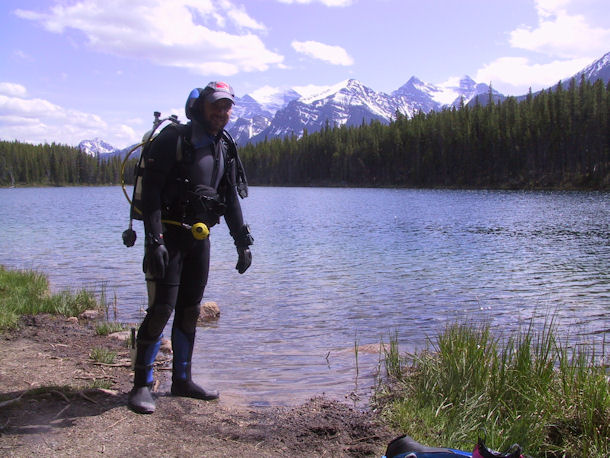
|
Allison Lake
After spending the first week of the trip on Vancouver Island, going on several interesting dives in the Pacific and the isle’s Sproat Lake, we returned to the Canadain mainland. First we drove to Allison Lake, an idyllic body of water that sits off the beaten track in the west of British Columbia. The lake has a mean depth of 15m; its maximum depth is 39m. When we arrived we discovered that a warning had been issued on the campsite. A ranger told us that at least two bears had recently been spotted in the area. So we set up some rattling cans, tin cans filled with stones hung from rope, that apparently keep the bears away from the camper vans (they don’t like the noise). Fortunately, the night passed without any visits from the bears.
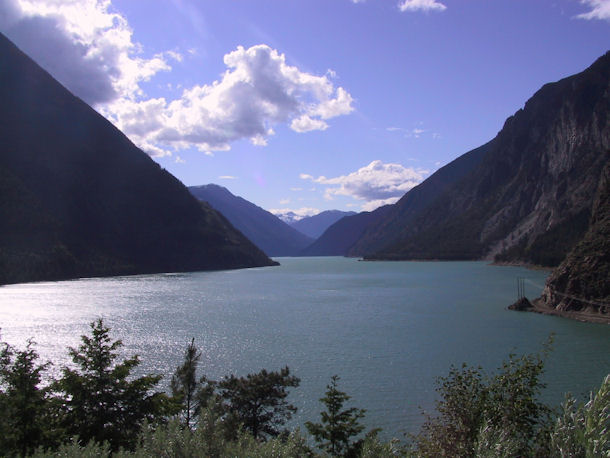 |
|
Pavilion Lake
The next day we drove on to the BC village of Pemberton and from there, to Lillooet, a former gold mining town. The climate was hot and dry, and the settlement’s architecture and landscape reminded me somehow of the old Westerns. In fact, there are still people walking around in cowboy hats. We camped at nearby Seton Lake, where an energy company runs a free camping site.
From there, we made a trip to Pavilion Lake, a body of water that runs along Marble Canyon. The lake is located between Lillooet and Cache Creek on BC Highway 99. Here you can rent canoes and enjoy magnificent mountain scenery. The lake is 5.8 km long, but has a maximum width of 0.8 km. It offers great entry points for diving. The water is crystal clear, but like most mountain lakes, there aren’t that many fish. The only fish I saw in Pavilion Lake were rainbow trout (Oncorhynchus mykiss).
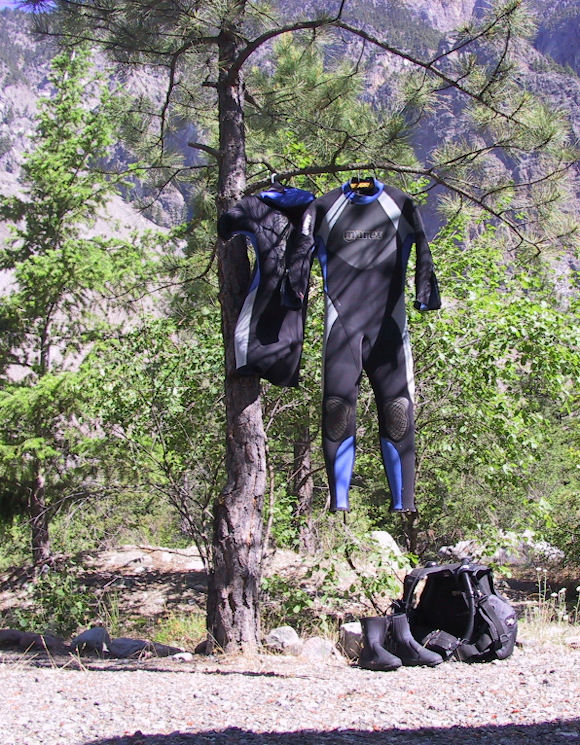 |
|
In Pavilion Lake, rocks of solidified microbial mats, so-called microbialites, can be found. They form stromatolites that, with their odd structure of tubers and columns, look a bit like cauliflowers. These are some of the earliest remains of life on earth. NASA and the Canadian Space Agency are running an astrobiological research project here, the Pavilion Lake Research Project (PLRP).
Not too far from the lake, non-divers can also search for fossil remains. About 13 km east of Cache Creek lies the McAbee Fossil Beds. We used a geologist's hammer to search for fossils here. We found fossil of leaves and flowers that had sank to the bottom of the lake about 50 million years ago, before being covered by fine sediment and algae, that later fossilised through carbonisation.
Searching fossils in den McAbee Fossil Beds
In Kamloops I had my bottles refilled and got another secret tip for diving and camping: the Johnson Lake.
Johnson Lake
Johnson Lake is located about 60 km north of Kamloops in the middle of the mountains. The lake is a little off the highway. For the last 35 km, we wound our way over a dusty gravel road until reaching what can be described as nothing else but a small paradise. Up here it is almost 10 °C cooler, but the fantastic nature compensates for the chill. The Johnson Lake Resort is managed by Jim & Barb Lewko. Everything is very homely and cosy. In the evening we had a barbecue and Jim gave us some fishing tips.
Right after breakfast I got ready to go diving. The lake is regarded as one of the clearest in British Columbia, dubbed the "Caribbean of the North". Actually, there are two lakes, the Big Johnson and the Little Johnson. I dived in the latter. It is indeed very clear, but in my opinion, not comparable to the visibility of Pavilion Lake. Unsurprisingly, we also found rainbow trout here.
After the dive I made a short trip to Big Johnson. The larger and smaller lakes are connected by a "fish ladder", an artificial structure designed to let fish follow their natural migration path. Hundreds of rainbow trout, having laid their eggs in the gravel bed in spring, swim over this “staircase” to reach Big Lake in the summer and autumn months. The whole canal was full of trout and at the pond, where the water was dammed, they were so numerous that they could almost have been caught by hand. Here it is forbidden to fish, dive, snorkel or disturb the wildlife in any way.
|
|
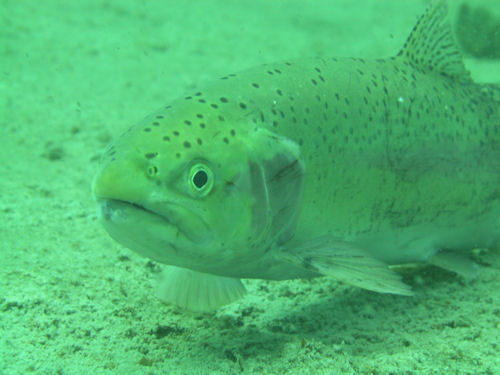 |
Kinney Lake
From Johnson Lake we drove on via Clearwater to Mt. Robson, the highest mountain of the Rocky Mountains with 3.954 m. Here we did a hike in Mount Robson Provincial Park along the mountain Lake Trail to Kinney Lake. This trail is one of the most beautiful of the Canadian Rockies. First we walked along the Robson River. In order not to be surprised by local bears, we clapped our hands and sang loudly. After a few kilometres we reached Kinney Lake. The body of water was turquoise blue and lay idyllically in the valley between snow-covered mountains. The view was exquisite. In the evening we were able to see several Wapiti deer while camping and the next day we saw black bears and coyotes.
|
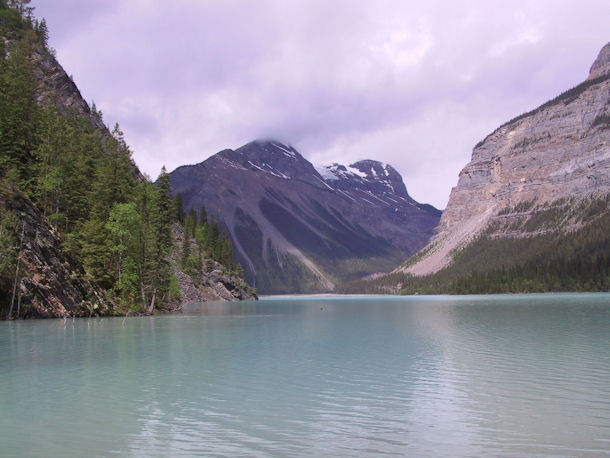
|
Lake Patricia (Jasper National Park/Alberta)
My next dive was in Lake Patricia, located in Jasper National Park in the province of Alberta. I didn't see a single fish in the expansive, clear mountain lake, but there were a lot of bugs. But the site is interesting because of its history. During the Second World War a prototype of an aircraft carrier made of ice was built in the lake.
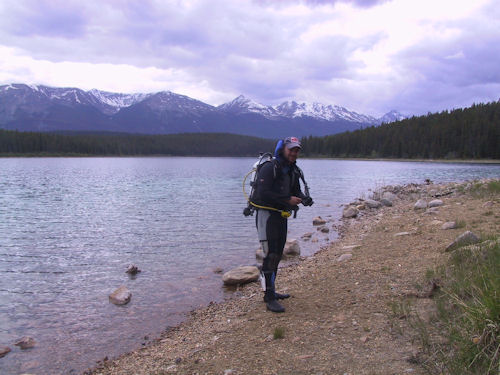 |
|
Project Habbakuk (also: Habakuk) - named after one of the biblical prophets – was the name given to the planned construction of a 1,200 m long and 180 m wide aircraft carrier made of ice. Up to 150 twin-engine bombers were to be stationed on the Habbakuk. The aircraft carrier was set to have 12m thick walls in order to be practically unsinkable - like an iceberg - also in case of large damages. Minor damages would have been easy to repair by spraying them with water, which would then freeze. Refrigeration systems in the ship would have prevented it from melting.
The idea of an aircraft carrier made of ice resulted from the fact that German submarines sank a large number of Allied ships in the Atlantic. In November 1942 alone, the Allies lost 134 ships to submarine attacks. The submarines mostly appeared in packs and could be fought effectively only by airplanes. However, the range of the reconnaissance planes and bombers was too small. Due to there being too few landing places in the Atlantic they could not operate far enough. The idea arose either to build an artificial island or to drag icebergs or large floes from the Arctic Ocean into the Atlantic to use them as flight bases. In the end, the idea was born to build an aircraft carrier out of ice.
The "Habbakuk" was to be assembled from 280,000 blocks of ice in Canada. Later, pykrete, a mixture of ice and ground wood pulp or sawdust, was used as the material, since this material was stronger than ice and melted more slowly. The ice-ship experiments were carried out in Canada’s Lake Louise in the summer of 1943. A small prototype made of ice was built at Lake Patricia. The dimensions of the ship were 18 x 9 m; the water displacement was 1,000 t. The ship was prevented from melting by a 1 hp refrigeration machine.
The "Habbakuk" project was discontinued after the Allies reached an agreement with Portugal at the end of 1943 that British and American airfields could be set up in the Azores.
Peyton Lake
After a visit to Columbia Icefield and a hike of several hours to the Wilkox Pass...
... we made a short stop at Peyton Lake. The mountain lake is located in Banff National Park, Canada's oldest national park. The turquoise blue lake is fed by glaciers.
We spent the night at Mosquito Creek.
Herbert Lake (Banff Nationalpark)
The last dive of this trip was in Herbert Lake. It is located in Banff National Park in the Canadian province of Alberta. Herbert was the first mountain lake where there was a lot of aquatic vegetation. The visibility wasn’t quite as impressive the other lakes, but with six to eight m, far better than what we’re used to. Once again, I didn’t see a single fish, but there were millions of crabs. There were so many of them that I could feel them crawling over my face, which was a quite unpleasant.
The lake is surrounded by the mountain ranges of the Canadian Rockies. The water’s surface was so smooth and clear that the stunning mountain scenery was reflected in it... Dreamlike!
The diving along the Pacific coast, the hot prairies, and the wild beauty of the Rocky Mountains is a must see. Unfortunately, the trip was over much too fast.
|
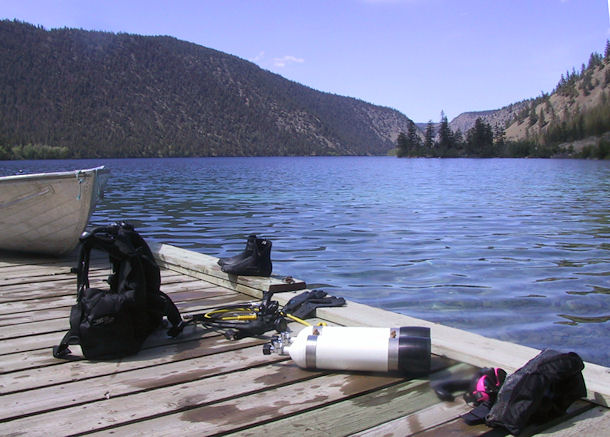
|
|
Tauchen: Rocky Mountains
Glasklares Wasser mit beeindruckenden Sichtweiten machen das Tauchen in den Bergseen der kanadischen Rocky Mountains zu einem ganz besonderen Erlebnis. Ab und zu schwimmt eine Forelle vorbei und wenn man auf-taucht schaut man auf eine der schönsten Landschaften, die es auf der Erde gibt. Gewaltige Gletscher und malerische Seen...
[mehr]
|
|
Tauchen in Vancouver
Das kalte Wasser des Nordpazifiks sorgt für aus-gezeichnete Sichtweiten. Riesenseesterne, Kelp-wälder und farbenprächtige Anemonen sind überall zu finden. Cousteau sagte einmal, dass die kanadischen Gewässer zu den besten Tauchplätzen der Welt gehören; für ihn die zweitbesten nach dem Roten Meer.
[mehr]
|
|
Zwischen Rockies und Pazifik
Kanada gilt als der Inbegriff unberührter Natur, Einsam-keit und Wildnisabenteuer. Weite Gebiete des riesigen Landes entsprechen auch tatsächlich diesem Bild: Unendliche Wälder mit 800 Jahre alten Baumriesen, glasklare Bäche und malerische Seen, reißende Flüsse und Wasserfälle sowie schneebedeckte Berge und gewaltige Gletscher...
[mehr]
|
|
Der Fischmann aus dem Lake Superior
In allen Teilen der Welt gibt es seit die Menschen zur See fahren Legenden von Meerjungfrauen und Meer-jungmännern. In Kanada ist eine Begegnung mit solch einem "Seeungeheuer" aus dem Jahre 1782 überliefert, als vier Reisende am Lake Superior ein ungewöhnliches Lebewesen, halb Mensch, halb Fisch, sahen.
[mehr]
|
|
|


